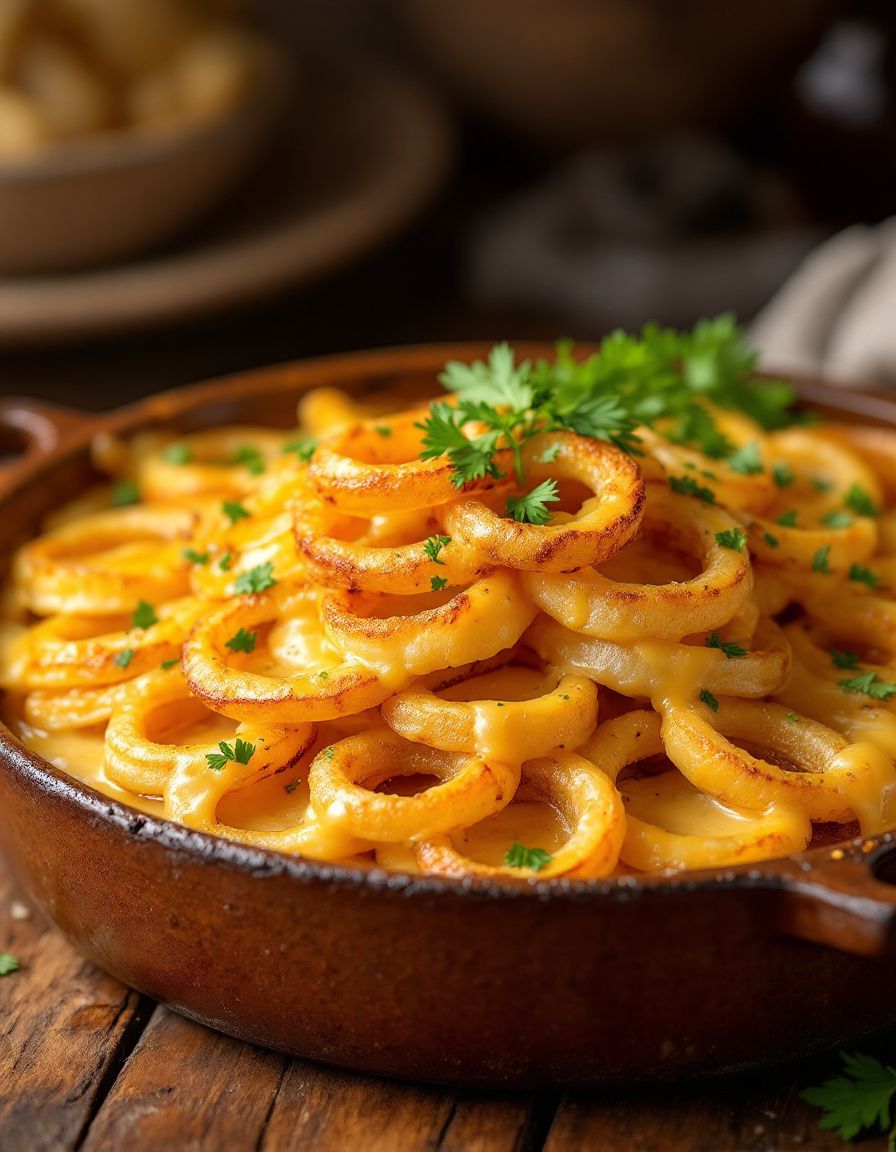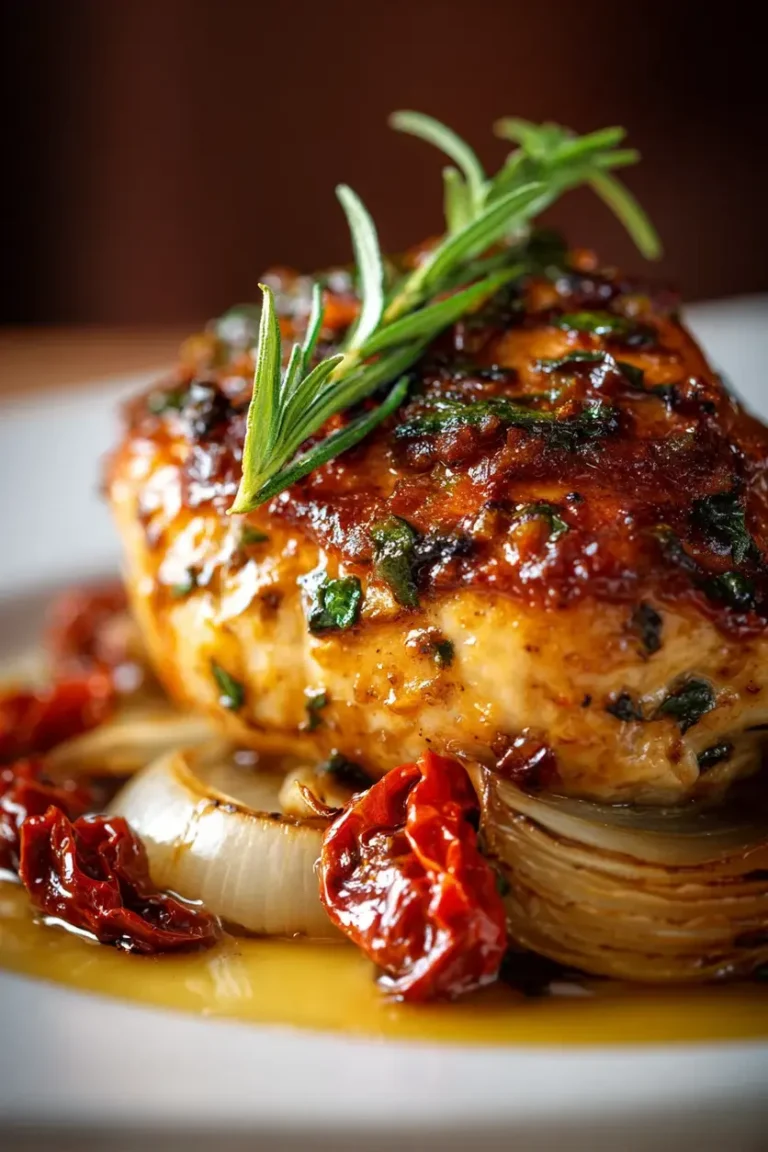Best Tennessee Onions Recipe – Ready in 30 Minutes

Tennessee Onions Recipe – Even Better Than Onion Rings!
Tennessee Onions are a game-changing appetizer that dances on your taste buds with an irresistible blend of flavors. Slices of sweet onions are dipped in a spiced batter, deep-fried to golden perfection, and served hot. Imagine biting into a hot, crispy onion ring, only to discover it’s even crispier, lighter, and bursting with flavor—this dish brings the warmth and hearty essence of Southern cooking into your kitchen. They’re perfect for casual gatherings or as a fantastic side dish to complement your favorite barbecue fare.
The aroma of frying onions fills the air as these Tennessee Onions cook, creating a comforting atmosphere that everyone loves. The crunchy exterior contrasts beautifully with the tender onion inside, making each bite a delightful series of textures. Whether you’re looking to impress guests at a dinner party or treat your family to a warm snack, this recipe is sure to become a favorite in your household.
Quick Recipe Highlights
- Flavor Profile: The combination of sweet onions and a savory batter creates a flavor explosion that is uniquely satisfying.
- Texture: Crispy on the outside and soft on the inside, these Tennessee Onions provide a delightful crunch with every bite.
- Aroma: The delightful smell of frying onions blended with spices will fill your kitchen and tantalize your senses.
- Visual Appeal: Golden brown and perfectly crispy, these onions are not only delicious but visually enticing as well.
- Skill Level Needed: Easy; even novice cooks can successfully create these delicious bites with simple steps.
- Special Equipment: A fryer or cast-iron skillet is essential for achieving that desirable crispy texture.
Recipe Overview
- Difficulty Level: This recipe is easy to follow, making it accessible for cooks of all skill levels. The straightforward preparation and cooking methods ensure that even beginners can tackle this dish without fear.
- Category: These Tennessee Onions can be classified as a snack or appetizer, perfect for parties, game days, or just a quick bite at home.
- Cuisine: Rooted in Southern U.S. culinary traditions, this dish reflects the comfort and hospitality often found in Tennessee cooking.
- Cost: Using budget-friendly ingredients like onions and pantry staples makes this dish both economical and satisfying.
- Season: While delicious year-round, these Tennessee Onions shine particularly bright during cooking season, when gatherings and barbecues are most frequent.
- Occasion: Ideal for casual gatherings, potlucks, or family barbecues, they make a fantastic crowd-pleaser.
Why You’ll Love This Recipe
One bite of Tennessee Onions and you’ll understand their appeal, showcasing a balance between sweet and savory. The crispy outer layer, combined with soft, warm onion, creates a mouthwatering texture that is hard to resist. These homemade delights elevate any meal or event, providing a familiar comfort food experience.
The convenience of this recipe cannot be overstated. With minimal prep time and straightforward cooking methods, these Tennessee Onions can be whipped up quickly for any impromptu gathering. They’re the ideal solution for last-minute snacks or appetizers when entertaining friends and family.
Nutritionally, while not a health food, using fresh ingredients like onions offers undeniable health benefits. Onions are packed with antioxidants and provide essential vitamins that can be part of a balanced diet, making this dish a bit more guilt-free.
Socially, these Tennessee Onions encourage sharing and conversation. Their delicious flavor profile makes them a fantastic centerpiece for gatherings, inviting guests to dig in and enjoy together. Serving these crispy bites can foster a warm and inviting atmosphere, perfect for creating cherished memories.
Finally, the cost-effectiveness of this recipe cannot be overlooked. With relatively cheap ingredients and a recipe that yields several servings, this dish is perfect for those on a budget without sacrificing taste or quality.
Historical Background and Cultural Significance
Tennessee Onions trace their origins back to the Southern United States, where comfort food and communal dining reign supreme. The practice of frying vegetables was popularized by Southern cooks who sought to enhance flavor and texture, making these onions an embodiment of regional culinary traditions.
These crispy bites have become a staple in many households across the South, often served during family gatherings and community events. They represent the hospitality and generosity that Southern cooking is famous for, inviting everyone to join in and enjoy.
Over the years, the recipe has evolved from simple fried onions to a beloved regional specialty, with each family adding their unique twist to the dish. This evolution reflects the creativity and adaptability of Southern cooks who make classic recipes their own.
In different regions, variations of fried onions exist, often influenced by local ingredients or culinary practices. This adaptability showcases the versatility of the dish and solidifies its place in Southern food culture.
Ingredient Deep Dive
The star ingredient in Tennessee Onions is the humble onion. Onions have been cultivated for thousands of years and are deeply ingrained in many cuisines worldwide. They provide an excellent base for flavor, and their natural sweetness is intensified when fried.
Nutritionally, onions are low in calories but high in vitamins and minerals. They offer antioxidant properties and support heart health. When selecting onions for this recipe, look for firm, unblemished bulbs without any soft spots. For storage, keep onions in a cool, dark place to maintain freshness, and they will last for weeks.
When it comes to substitutes, yellow sweet onions are preferred for their mild flavor, but other varieties such as red or white onions can work in a pinch. Each type of onion will offer a different taste and level of sweetness.
Common Mistakes to Avoid
- Overcrowding the frying pan: This can lead to uneven cooking and soggy onions. Make sure to cook in small batches.
- Using the wrong oil: Choose oils with a high smoke point, such as vegetable or canola oil, for frying.
- Not heating the oil enough: If the oil isn’t hot enough, the batter will absorb grease, leading to soggy results instead of crispy ones.
- Skipping the seasoning: A good sprinkle of salt and spices can elevate the flavor immensely; don’t skip this step.
- Cutting the onions too thick: Uniform, thin slices will ensure even cooking and a perfect texture.
- Neglecting to batter properly: The batter should coat the onion slices evenly for a nice crunch; be sure to follow the recipe’s batter instructions.
- Inadequate draining time: Allow the cooked onions to drain on paper towels to remove excess oil and maintain crispiness.
- Not tasting the batter: Always taste and adjust the seasoning of the batter before frying; the flavor should resonate beyond just the onions.
- Using expired ingredients: Fresh ingredients, including spices, ensure maximum flavor. Check your pantry for outdated items.
- Not letting the oil cool down after frying: This can lead to burnt oil, which affects the taste and healthiness of your dish.
Essential Techniques
Achieving the perfect fry is essential in creating Tennessee Onions. The key is to maintain the right oil temperature—around 350°F (175°C). Use a thermometer for accuracy, and if you don’t have one, test with a small piece of batter; if it sizzles and rises to the surface, your oil is ready.
Creating a flavorful batter brings depth to your dish. Ensure that the batter coats the onions lightly but thoroughly. Whisk together flour, cornmeal, and seasonings until well combined, then dip each onion slice carefully to ensure no dripping occurs as this can lead to unreliable texture.
Pro Tips for Perfect Tennessee Onions
Use a combination of flour and cornmeal in the batter for extra crunch. The cornmeal gives a distinct texture that elevates the final dish.
Let the batter rest for about 15 minutes before using. This helps the ingredients meld together and improves adherence to the onion slices for a better fry.
Try adding spices to the batter for amplified flavor; garlic powder, cayenne pepper, or even smoked paprika can introduce new taste dimensions.
Toast the spices before adding them to the batter to bring out their flavor. Simply heat them lightly in a pan until fragrant—this makes a noticeable difference in the final taste.
Change up the onion variety—that is, experiment with Vidalia onions or even shallots for a unique twist and different flavors.
Consider serving with a dipping sauce, like ranch or spicy aioli, to enhance the eating experience and provide more layers of flavor.
Variations and Adaptations
There are countless ways to adapt Tennessee Onions to fit your taste or dietary needs. For a spicier version, add diced jalapeños to the batter for an extra kick. Alternatively, for a milder approach, use sweet Vidalia onions instead of traditional yellow onions.
Seasonal adaptations are also possible; for instance, you can integrate herbs like fresh parsley or basil into the batter during the summer months for a fresher flavor profile.
Dietary modifications can cater to various preferences or restrictions. For a gluten-free version, substitute regular flour with a gluten-free blend, or use chickpea flour for a different flavor and texture available to create a delicious dish.
For those looking for a healthier option, consider baking instead of frying. Preheat the oven and spray the coated onion rings lightly with cooking spray before baking them until golden brown.
Serving and Presentation Guide
When serving Tennessee Onions, presentation is key. Consider using a large platter lined with parchment paper to absorb excess oil, then arrange the fried onions in an overlapping fashion for a beautiful display.
Garnishing with fresh herbs like parsley or chives not only adds color but also a fresh flavor that contrasts beautifully with the fried texture. For a playful touch, serve with a variety of dipping sauces in small bowls on the side.
Traditional accompaniments might include a classic Southern remoulade or spicy ketchup, which enhances the flavor profile and gives your guests options.
For modern flair, consider serving them with a zesty avocado dipping sauce or a yogurt-based dip for a twist on flavors.
Temperature consideration is important as well; serve these hot and fresh out of the fryer for maximum enjoyment, but if they need to be held before serving, keep them in a warm oven to maintain their crunch.
Lastly, balanced portion control is essential, especially at gatherings; consider offering small portions to encourage tasting multiple appetizers without overwhelming guests.
Wine and Beverage Pairing
When it comes to pairing beverages with Tennessee Onions, you’ll want something that complements their rich, savory crunch. A crisp, chilled white wine such as Sauvignon Blanc or a light sparkling wine like Prosecco can cut through the fried elements beautifully.
For non-alcoholic options, consider an iced tea with fresh lemon or a sparkling water with lime to refresh the palate alongside these savory bites.
If you choose to serve coffee or tea, opt for a richly brewed brew that will balance the fried flavors, such as a dark roast coffee or a spiced chai tea.
Temperature is key; serve your cold drinks well-chilled, while any hot beverages should maintain warmth to offer contrast to the crispy fried onions.
Storage and Shelf Life
To store leftover Tennessee Onions, allow them to cool completely before transferring them to an airtight container. Store in the refrigerator for up to 3 days. For best quality, consume them within this time frame to avoid sogginess.
If you’d like to freeze them, flash freeze the onions on a baking sheet before transferring them to a freezer-safe bag. This prevents them from clumping together, and they can last for up to 2 months in the freezer.
Signs of spoilage include a sour smell or soggy texture. If the color has changed significantly, it’s best to err on the side of caution and discard them.
When reheating, avoid the microwave as it tends to make fried foods soggy. Instead, reheat in an oven or air fryer to restore their original crunch.
Make Ahead Strategies
To make Tennessee Onions ahead of time, you can prepare the batter and onion slices a few hours in advance. Keep the batter refrigerated to enhance its flavor, allowing it to come to room temperature before frying.
If you plan to serve them at an event, consider frying the onions just before serving and then placing them in a warm oven to keep them crisp until it’s time to eat.
You can also slice the onions and store them in water, which will keep them fresh while preventing browning. Just be sure to drain thoroughly before coating and frying.
Assessing quality after freezing is critical; always check them for any ice crystals or freezer burn that might affect texture and taste.
Fresh elements like herbs or zesty sauces can be added right before serving to enhance flavor and freshness without compromising the crispy texture.
Scaling Instructions
To halve this recipe, simply reduce all ingredients by half, ensuring you still maintain the ratio of batter to onion slices. This is ideal for small gatherings or when you want to avoid leftovers.
Doubling or tripling the recipe is straightforward as well; just be aware that cooking times may vary depending on the quantity you’re frying at once. Make sure to cook in batches to ensure even frying and optimal crispiness.
Adjustments in equipment may be necessary; a larger pot or additional frying pans can accommodate higher volumes. Always ensure there’s enough space for the onions to cook evenly.
For timing modifications, keep a close eye on cooking times as larger batches may require slightly longer frying.
Storage considerations are key; ensure that your containers can accommodate larger quantities without compromising the freshness of fried items.
Nutritional Deep Dive
Tennessee Onions provide a satisfying snack that is relatively light compared to other fried foods. A standard serving typically accounts for around 200 calories, depending on the size and oil absorption.
They contain a mix of carbohydrates primarily from the flour used in the batter, which contributes to energy levels. Onions, being high in vitamins C and B6, contribute positively to your overall nutritional intake.
Micronutrient analysis reveals that onions are an excellent source of flavonoids, which are beneficial for heart health. The dietary fiber in onions assists in digestion, promoting a healthy gut.
For those managing their diet, portion size can affect both caloric intake and satisfaction. Pairing these fried snacks with fresh veggies or a salad can create a balanced meal.
A weight management tip is to enjoy these Tennessee Onions in moderation, balancing them with lighter dishes and plenty of fresh produce at meals to maintain a well-rounded diet.
Dietary Adaptations
For gluten-free adaptations, replace regular flour with a certified gluten-free flour blend or chickpea flour. This allows those with gluten sensitivities to enjoy this delightful dish without worry.
Dairy-free modifications can be made by opting for nut milks or plant-based yogurt in the batter instead of traditional dairy products, ensuring a similar consistency and flavor.
Vegans can enjoy these Tennessee Onions by ensuring all ingredients are plant-based. Use plant-based milk and a suitable flour without animal byproducts to maintain the essence of the recipe.
For those following low-carb or keto diets, consider using almond flour instead of regular flour to create a batter that fits within those dietary boundaries.
Paleo diets can be accommodated as well by using coconut flour or almond flour and ensuring no processed high-carb elements are included.
For individuals who are on a low-FODMAP diet, select quantities and types of onions that meet low-FODMAP recommendations to maintain the integrity of your diet while enjoying this dish.
Troubleshooting Guide
If you encounter texture issues such as sogginess, it may be due to contamination during the frying process; ensure to shake off excess batter before frying and use paper towels to drain properly.
For flavor balance, consider adjusting your seasonings in the batter by adding more salt or spices throughout the mixing procedure. Always be sure to taste the batter before cooking.
Temperature problems often arise if the oil isn’t properly preheated. Using a thermometer can help; if the oil is too hot, your onions will burn, while too cool results in greasy food.
Equipment challenges might arise if you’re using non-stick pans or materials that aren’t suitable for frying; utilize cast iron or heavy-duty pots for best results.
Ingredient substitutions can alter taste or texture; ensure you understand the properties of any replacements to maintain balance within the dish.
Timing concerns relate to overcooking or undercooking; always keep a close eye on the frying process, and if your first batch overcooks, adjust time on subsequent batches.
Recipe Success Stories
Community feedback on Tennessee Onions often highlights their adaptability and approachability. Many people share their experiences of customizing the recipe with different spices or onion varieties to great success.
Readers have enjoyed experimenting with the batter, resulting in exciting new variations. Whether incorporating different herbs or spices, the ability to adjust based on preference has delighted many home cooks.
Adaptation stories feature families sharing the dish across generations. Many cook this recipe as a culture of tradition, bringing relatives together at gatherings to savor a taste of home.
Photography tips from try-at-home cooks indicate the importance of taking pictures of onions before they are fried, highlighting their wonderfully crisped appearance once cooked for social media.
Ultimately, the success stories focused on how this recipe fosters connection and creates lasting memories, embodying the spirit of shared meals and Southern hospitality.
Frequently Asked Questions
Any variety can work, but yellow onions are the most commonly used due to their sweetness and mild flavor. Sweet Vidalia onions are also a great option if you prefer a sweeter taste.
Can I bake Tennessee Onions instead of frying them?
Yes, you can bake them! Simply preheat your oven to 400°F, spray them lightly with oil, and bake until golden brown, flipping once for even cooking.
How do you store leftovers?
Allow the onion rings to cool completely, then store them in an airtight container in the fridge for up to three days. Reheat in the oven for best results.
Can I make the batter ahead of time?
Absolutely! You can prepare the batter several hours in advance and store it in the refrigerator. Just let it come to room temperature before using.
What can I serve with Tennessee Onions?
These delicious bites pair beautifully with a variety of dips such as ranch dressing, spicy aioli, or even a zesty remoulade.
Is it possible to make Tennessee Onions gluten-free?
Yes! Simply swap regular flour for a gluten-free flour blend or use chickpea flour for a delicious and gluten-free alternative.
How spicy can I make them?
You can adjust the spice level in the batter by adding spices like cayenne pepper or using spicy dipping sauces.
Can you make Tennessee Onions in an air fryer?
Yes! Preheat your air fryer, spray the onions with oil, and cook them in batches until crispy and golden.
Are these onions suitable for kids?
Generally, yes! They offer mild flavors and a fun crunch, making them perfect for kids, especially when served with a tasty dipping sauce.
What to do if I don’t have a deep fryer?
You can effectively fry these onions in a large, deep skillet or pot. Just ensure the oil is deep enough to submerge the onions for even cooking.
Additional Resources
If you enjoyed making Tennessee Onions, consider trying other related recipes, such as zucchini fritters or fried pickles, which offer similar textures and flavors.
Explore technique guides on frying basics and the best oils to use for frying to ensure perfect results every time.
Learn more about ingredient information related to onions, their varieties, and how they impact flavor and nutrition in your recipes.
Equipment recommendations for fryers, skillets, and thermometers will set any home cook up for success in making wonderful fried snacks and dishes.
Additionally, check out seasonal variations of this recipe, which encourage incorporating fresh herbs or vegetables according to what’s in season for a more vibrant dish.
Join the Conversation
We love hearing from our readers! Share your experience with Tennessee Onions on social media. Post photos of your creations and tag us to inspire other cooks.
Engage with our community by sharing your own variations or adaptations to the recipe, contributing to the diverse culture of home cooking.
If you enjoyed the recipe, we’d appreciate your reviews and suggestions. Help us improve this dish and make it even better for everyone.
We encourage everyone to leave comments with questions or share tips on perfecting Tennessee Onions, enriching our community dialogue.
Feel free to participate in discussions about favorite Southern appetizers or other fried delights that accompany these delicious onions, fostering inspiration for our culinary adventures.
The Recipe
Tennessee Onions
Serves: 4
Prep Time: 15 mins
Cook Time: 20 mins
Total Time: 35 mins
Kitchen Equipment Needed
- Deep fryer or deep skillet
- Slotted spoon
- Thermometer (optional)
- Mixing bowls
Ingredients
- 2 large sweet onions
- 1 cup all-purpose flour
- 1 cup cornmeal
- 2 teaspoons paprika
- Salt and pepper to taste
- 1 cup buttermilk
- Oil for frying
Directions
- Slice the onions into thick rings and soak them in buttermilk for at least 10 minutes.
- In a separate bowl, combine flour, cornmeal, paprika, salt, and pepper.
- Heat oil in a deep fryer or large skillet to 350°F (175°C).
- Remove onions from buttermilk, allowing excess to drip off, and coat in the flour mixture.
- Fry onion rings in batches until golden brown, around 3-4 minutes per side.
- Remove and drain on paper towels; season with additional salt while hot.
- Serve with your favorite dipping sauce.
Recipe Notes
- For gluten-free, substitute flour with gluten-free flour blend.
- Feel free to experiment with spices in the batter for added flavor.
- These can also be baked if you’re looking to reduce frying oil intake.






